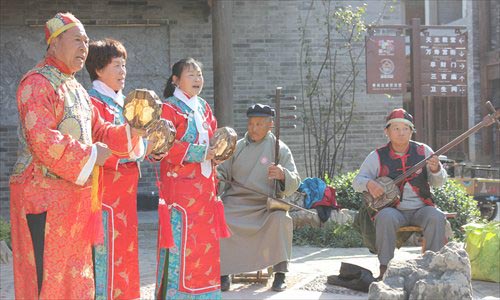 |
|
Singers led by Guan Lianju(left) perform traditional Manchu ethnic minority music in Weifang, Shandong Province.[Photo/Global Times]
|
Walking through the gateway of the huge gate tower, Weifang suddenly became a city that transported me back in history. Cinereous walls, traditional buildings, an old man playing the traditional two-stringed bowed instrument known as the erhu, a grandma knitting shoes patterned after a tiger, a man pushing a wooden one-wheeled trolley selling fruit, these were scenes that I had only seen in period films or TV series. However, there they were right before me in Weifang city, Shandong Province.
The best part of traveling is experiencing authentic local culture and customs. Yet, the rapid expansion of urbanization and development has made it difficult for traditional cultures to be seen by not only foreigners, but also locals. In some areas traditions are on the verge of disappearing altogether.
To better preserve the region's intangible culture heritage, the Qingzhou government in Weifang has implemented a program that seeks to use tourism to preserve culture. With performers demonstrating local culture heritages on the street, people now have a greater chance to learn about these disappearing skills as well as to look back at the traditions of the past.
Disappearing culture
I sat on a bench on the city's cultural street and watched as five older men and women wearing clothing dating to the Qing Dynasty (1644-1911) sang and beat a rhythm on small hand-held octagonal drums. Both the instrument and the singing have been listed as part of the province's protected cultural heritage since it belongs to the Manchu ethnic group and there are only a few people alive today who know how to play.
Lead singer Guan Lianju explained that the octagon represents the eight banners system that was used to organize Manchu society during the Qing. He himself belongs to Xianghuang banner, one of the upper three banners in the hierarchy. Sung in the Manchu dialect, he said that as far as he knows, in addition to himself, the four other singers are the only people who know how to perform this music.
We Recommend:
